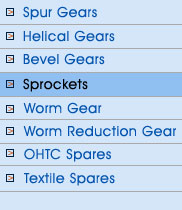

Sprockets Manufacturer
Chain Drive:
Chain drives are used where positive action is required. The velocity is constant
to some extent. Power is transmitted, in this case over a shorter distance than
in the case of belt or rope drives. Chains are made up of rigid links and of various
types. They are classified as: The wheels over which chain runs are called sprocket wheels. These wheels have projecting teeth which fit the suitable recess in the links of the chain and thus enable a positive drive to be obtained. The pitch of the chain is defined as the distance between a hinge center of one link to the corresponding hinge center of the adjacent link. The pitch circle diameter of the chain sprocket is the diameter of the circle on which the hinge centers lie, when the chain is wrapped round the sprocket. Quality:
Sources of errors in manufacturing gears: The
various sources of errors in the gear made by reproducing method can be due to
The
sources of error when gears are made by generating method are: |
